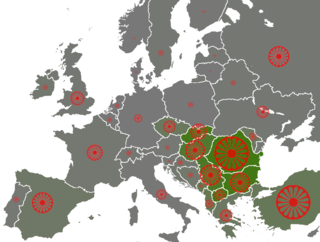
The Romani people, also known as the Roma, are an ethnic group of Indo-Aryan origin who traditionally lived a nomadic, itinerant lifestyle. Linguistic and genetic evidence suggests that the Roma originated in the Indian subcontinent, in particular the region of Rajasthan. Their first wave of westward migration is believed to have occurred sometime between the 5th and 11th centuries. Their name is from the Sanskrit word डोम which translates into a member of the Dom caste of travelling musicians and dancers. The Romani population moved west into the Ghaznavid Empire and later into the Byzantine Empire. The Roma are thought to have arrived in Europe around the 13th to 14th century. Although they are widely dispersed, their most concentrated populations are believed to be in Bulgaria, Hungary, Romania, Serbia and Slovakia.
Romani is an Indo-Aryan macrolanguage of the Romani communities. According to Ethnologue, seven varieties of Romani are divergent enough to be considered languages of their own. The largest of these are Vlax Romani, Balkan Romani (600,000), and Sinte Romani (300,000). Some Romani communities speak mixed languages based on the surrounding language with retained Romani-derived vocabulary – these are known by linguists as Para-Romani varieties, rather than dialects of the Romani language itself.
Iranians or Iranian people may refer to:
Bohemian Romani or Bohemian Romany was a dialect of Romani formerly spoken by the Romani people of Bohemia, the western part of today's Czech Republic. It became extinct after World War II, due to the genocide of most of its speakers in extermination camps by Nazi Germany.

Domari is an endangered Indo-Aryan language, spoken by Dom people scattered across the Middle East and North Africa. The language is reported to be spoken as far north as Azerbaijan and as far south as central Sudan, in Turkey, Iran, Iraq, Israel, Palestine, Jordan, Egypt, Sudan, Libya, Tunisia, Algeria, Morocco, Syria and Lebanon. Based on the systematicity of sound changes, it is known with a fair degree of certainty that the names Domari and Romani derive from the Indo-Aryan word ḍom. Although they are both Central Indo-Aryan languages, Domari and Romani do not derive from the same immediate ancestor. The Arabs referred to them as Nawar as they were a nomadic people that originally immigrated to the Middle East from the Indian subcontinent.
The Romani people, also referred to as Roma, Sinti, or Kale, depending on the subgroup, are an Indo-Aryan ethnic group that primarily lives in Europe. The Romani may have migrated from what is the modern Indian state of Rajasthan, migrating to the northwest around 250 BC. Their subsequent westward migration, possibly in waves, is now believed to have occurred beginning in about 500 AD. It has also been suggested that emigration from India may have taken place in the context of the raids by Mahmud of Ghazni. As these soldiers were defeated, they were moved west with their families into the Byzantine Empire.

The Romani people are a distinct ethnic and cultural group of peoples living all across the globe, who share a family of languages and sometimes a traditional nomadic mode of life. Though their exact origins were unclear, recent studies show Kashmir in Northwest India is the most probable point of origin. Their language shares a common origin with, and is similar to, modern-day Gujarati and Rajasthani, borrowing loanwords from languages they encountered as they migrated from India. In Europe, even though their culture has been victimized by other cultures, they have still found a way to maintain their heritage and society. Indian elements in Romani culture are limited, with the exception of the language. Romani culture focuses heavily on family. The Roma traditionally live according to relatively strict moral codes. The ethnic culture of the Romani people who live in central, eastern and southeastern European countries developed through a long, complex process of continuous active interaction with the culture of their surrounding European population.

The Lyuli, Jughi or Jugi are a branch of the Ghorbati people living in Central Asia, primarily Tajikistan, Uzbekistan, Turkmenistan, Kazakhstan, and southern Kyrgyzstan; also, related groups can be found in Turkey, and the Balkans, Crimea, Southern Russia and Afghanistan. They speak ethnolects of the Persian and Turkic language and practice Sunni Islam. The terms Lyuli and Jugi are considered pejorative. They have a clan organization. Division into sub-clans is also practiced. The Lyuli community is extremely closed towards non-Lyuli.
The Garachi, also spelled Karachi or Karaci, are a group of the Dom people living in Azerbaijan and Turkey. Little research has been done on the Garachi, and most of what is known about them is based on the works of the 19th-century Russian scholars Kerope Patkanov and Jean-Marie Chopin.

The Romani people have several distinct populations, the largest being the Roma and the Calé, who reached Anatolia and the Balkans in the early 12th century, from a migration out of the Indian subcontinent beginning about 1st century – 2nd century AD. They settled in the areas of present-day Turkey, Greece, Serbia, Romania, Croatia, Moldova, Bulgaria, North Macedonia, Hungary, Albania, Kosovo, Bosnia and Herzegovina, Czech Republic, Slovenia and Slovakia, by order of volume, and Spain. From the Balkans, they migrated throughout Europe and, in the nineteenth and later centuries, to the Americas. The Roma population in the United States is estimated at more than one million.

The presence of Romani people in Ukraine was first documented in the early 15th century. The Romani maintained their social organizations and folkways, shunning non-Romani contacts, education and values, often as a reaction to anti-Romani attitudes and persecution. They adopted the language and faith of the dominant society, being Orthodox in most of Ukraine, Catholic in Western Ukraine and Zakarpattia Oblast, and Muslim in Crimea.
The Romani people are known by a variety of names, mostly as Gypsies, Roma, Tsinganoi, Bohémiens, and various linguistic variations of these names. There are also numerous subgroups and clans with their own self-designations, such as the Sinti, Kalderash, Boyash, Manouche, Lovari, Lăutari, Machvaya, Romanichal, Romanisael, Kale, Kaale, Xoraxai and Modyar.
The Ghorbati are an ethnic group and originally a nomadic community in Iran, Afghanistan and Central Asia, where they are part of the various communities termed Lyuli. They are mostly situated in Iran, where others have migrated from. They trace their ancestry to Sassanid Persia.
Gypsy music may refer to:
Zargari is a dialect of Balkan Romani, spoken in Zargar region of the Qazvin Province of in Iran by the ethnic Zargari people. The language can be found in surrounding regions as well. It is one of the only Indo-Aryan languages still spoken in Iran, and is considered endangered. Zargari takes its name from the Persian word for "goldsmith".
The Zargari people are a Muslim Romani ethnic group that live in Zargar, in northwestern Iran. They speak Zargari Romani, a distinct dialect of Balkan Romani most closely related to dialects historically spoken in Rumelia.

Romani Americans are Americans who have full or partial Romani ancestry. It is estimated that there are one million Romani people in the United States. Though the Romani population in the United States has largely assimilated into American society, the largest concentrations are in Southern California, the Pacific Northwest, Southwestern United States, Texas, Louisiana, Florida and the Northeast as well as in cities such as Chicago, Cleveland, and St. Louis.
The Abdals are a largely Turkish-speaking ethnic group found in much of Anatolia and parts of the Balkans and Syria, who follow an itinerant lifestyle. This lifestyle is closely connected with the activity of music making at weddings and circumcision parties. Other occupations associated with the Abdal include tinning, basket making and sieve manufacture.
The Romani people in Canada are citizens of Canada who are of Romani descent. According to the 2021 Canadian census there were 6,545 Canadians who claimed Romani ancestry. They are sometimes referred as "gypsies", but that is considered to be a racial slur.
Persian Romani, also known as Ghorbati (Qorbati), Magadi (Mogadi), Qazulagi and Jogigi, Lafzi Mugat or Arabi/Arabcha in Central Asia, refers to various argots, spoken by the Ghorbati and closely related peoples, often called “Persian Gypsies” or “Central Asian Gypsies”. There is no proof of any historical connection between any of these peripatetic groups and the Roma or Dom peoples, except for the fact that some use a few words that are apparently of Domari origin. These argots are related to Lotera’i, or Judeo-Persian.






